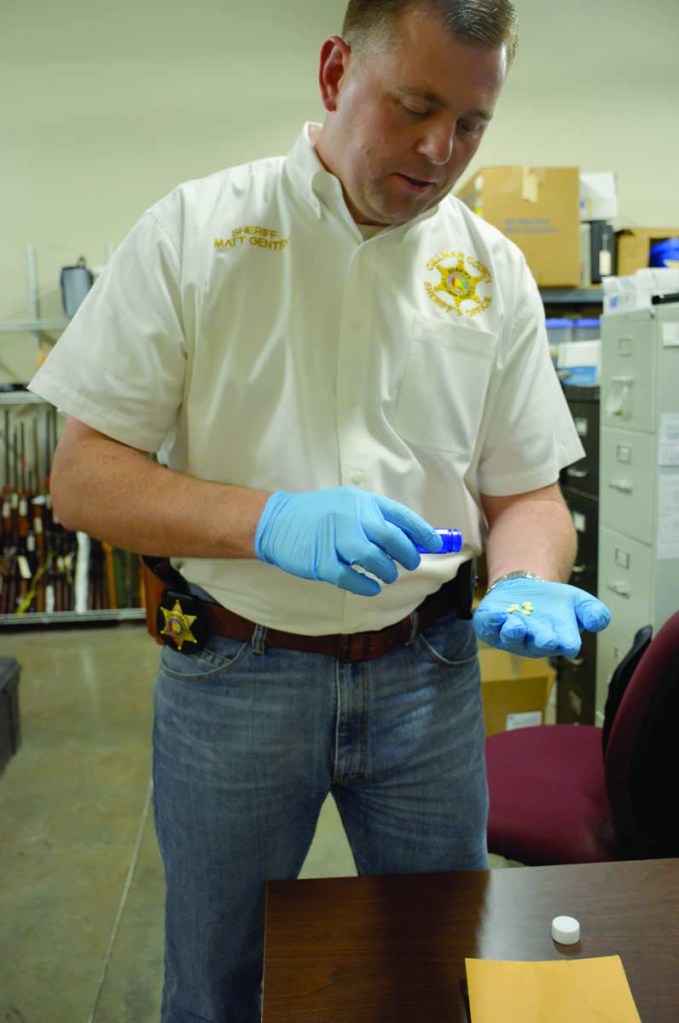Coroner says heroin overdoses on the rise in Cullman area
Published 10:19 pm Saturday, August 22, 2015

- Cullman County Sheriff Matt Gentry shows clonazepam, an anti-anxiety medication, pills the department seized as evidence in a drug investigation. Gentry said many people addicted to prescription drugs and illegal drugs mix clonazepam and other anti-anxiety medication, like Xanax, with other drugs — prescription and illegal — to make a deadly cocktail.
Cullman County residents are dying from a deadly cocktail of prescription and illegal drugs — and now, a growing number of heroin overdoses.
August alone has seen two suspected heroin overdoses, claiming a man in his 30s and a woman in her 50s. In April, a woman in her late-30s died of a suspected heroin overdose. All three cases have been sent to the Alabama Department of Forensic Sciences to be confirmed by toxicology screens, said Cullman Coroner Jeremy Kilpatrick.
Trending
Since taking office in January, Kilpatrick has been tracking drug overdose cases more thoroughly. He reviewed cases in 2013 and 2014 and discovered two occurred each year for a total of four.
However, that number may only be a glimpse of the true magnitude of heroin addiction in the county. Those death cases were confirmed by toxicology reports, and officials say there are countless other suspected drug overdoses where toxicology screens were not ordered and even more cases where Cullman County residents have died in neighboring counties from heroin overdoses.
Cullman County Sheriff Matt Gentry, who warned about a burgeoning heroin epidemic during his successful 2014 campaign run, said residents are driving to Birmingham to buy cheap, high-quality heroin and bringing it to Cullman County to use and sell to other addicts.
Heroin has ravaged Birmingham and its suburbs over the past three years, with heroin overdoses nearly doubling in Jefferson County from 2011 to 2012 — climbing from 30 to 58. The number of heroin deaths also soared, from 15 to 82, between 2008 and 2012 in Jefferson, Shelby and Tuscaloosa counties. The rise in heroin deaths leveled off for a year, but took off again in 2014, with 137 in Jefferson County alone, according to Joyce White Vance, U.S. Attorney for the Northern District of Alabama.
According to the Centers for Disease Control (CDC), heroin use has increased among men and women, most age groups and all income levels. Some of the greatest increases occurred in demographic groups with historically low rates of heroin use: women, the privately insured, and people with higher incomes.
Not only are people using heroin, they are also abusing multiple other substances, especially cocaine and prescription opioid painkillers. As heroin use has increased, so have heroin-related overdose deaths. Between 2002 and 2013, the rate of heroin-related overdose deaths nearly quadrupled, and more than 8,200 people died in 2013.
Trending
Heroin use more than doubled among young adults ages 18 to 25 in the past decade, according to the CDC. More than 9 in 10 people who used heroin also used at least one other drug, and 45 percent of people who used heroin were also addicted to prescription opioid painkillers.
Gentry said for more than a decade, law enforcement has been attacking the methamphetamine problem but now is the time authorities look at the emerging heroin problem.
“We’ve got to start attacking the heroin epidemic,” he said. “Education is the strongest tool we have to ward off potential users. It’s a balancing act of enforcement, education and rehabilitation.”
Gentry said his department has made a handful of heroin possession cases recently. Cullman Police Chief Kenny Culpepper said authorities are now treating accidental drug overdoses as homicides under new federal guidelines.
“If we can trace the drugs that killed someone back to the person they got it from, they can be charged with murder,” he said.
While heroin is beginning to kill more residents, a deadly cocktail of prescription drugs is responsible for most overdose deaths in Cullman County, according to Kilpatrick’s review of death cases.
So far in 2015, there have been three confirmed overdose deaths from poly-pharmacy — two or more prescription drugs. Three other deaths were from alcohol and five from illegal drugs in 2015. Of the nine traffic fatalities in Cullman County so far this year, four — nearly half — of the victims were under the influence of alcohol or prescription or illegal drugs, Kilpatrick said.
“Across the board, the drug problem we have here is just ridiculous,” Kilpatrick said. “We’ve had six drug overdoses in July, two of which we’re still waiting on toxicology to come back. From what I’ve seen, poly-pharmacy drug overdose is a big problem for Cullman County. Most of the illegal drug overdoses I’ve seen are people under 50.”
One of those July overdose deaths involved a man who had just gone to the doctor and was prescribed a 90-day supply of morphine and Xanax, Kilpatrick said.
“Only 30 days of medicine was left when I worked the death call,” he said.
In 2013, 13 deaths were the result of poly-pharmacy overdose. Eight other deaths were from illegal drugs, including the two heroin deaths.
In 2014, 13 deaths were also from poly-pharmacy overdose and 10 from illegal drugs, of which two were attributed to heroin. The 2014 numbers are incomplete though.
Kilpatrick said he only reviewed 23 overdose death cases for the year. He didn’t review a dozen or so additional death cases involving drug overdose but he said poly-pharmacy was likely the cause in a bulk of those deaths.
And there may be even more drug overdose deaths; Kilpatrick said he didn’t review any death cases where an autopsy was conducted.
“After February, I’ll have better statistics to work with,” he said.
He said many poly-pharmacy overdose cases involve older residents who suffer from chronic illnesses and take multiple prescription medications.
“Somebody is going to this doctor and getting this medication, going to this doctor over here for this other medication and then another for this,” Kilpatrick said. “They don’t realize those medications can interact with each other.”
Kilpatrick said toxicology reports are ordered in death cases if drug paraphernalia is found at the scene, in all traffic fatalities and most suicides. The coroner has the discretion to order toxicology reports, and the district attorney can decide to order autopsies during which toxicology is part of the forensic process.
- Heroin is processed from morphine, a naturally occurring substance extracted from the seed pod of certain varieties of poppy plants grown in Southeast and Southwest Asia, Mexico, and Colombia.
- Heroin can be injected, smoked, or snorted. High purity heroin is usually snorted or smoked.
- Physical symptoms of heroin use include: Drowsiness, respiratory depression, constricted pupils, nausea, a warm flushing of the skin, dry mouth, and heavy extremities
- Effects of a heroin overdose are: Slow and shallow breathing, blue lips and fingernails, clammy skin, convulsions, coma, and possible death.
Source: U.S. Drug Enforcement Agency (DEA)





